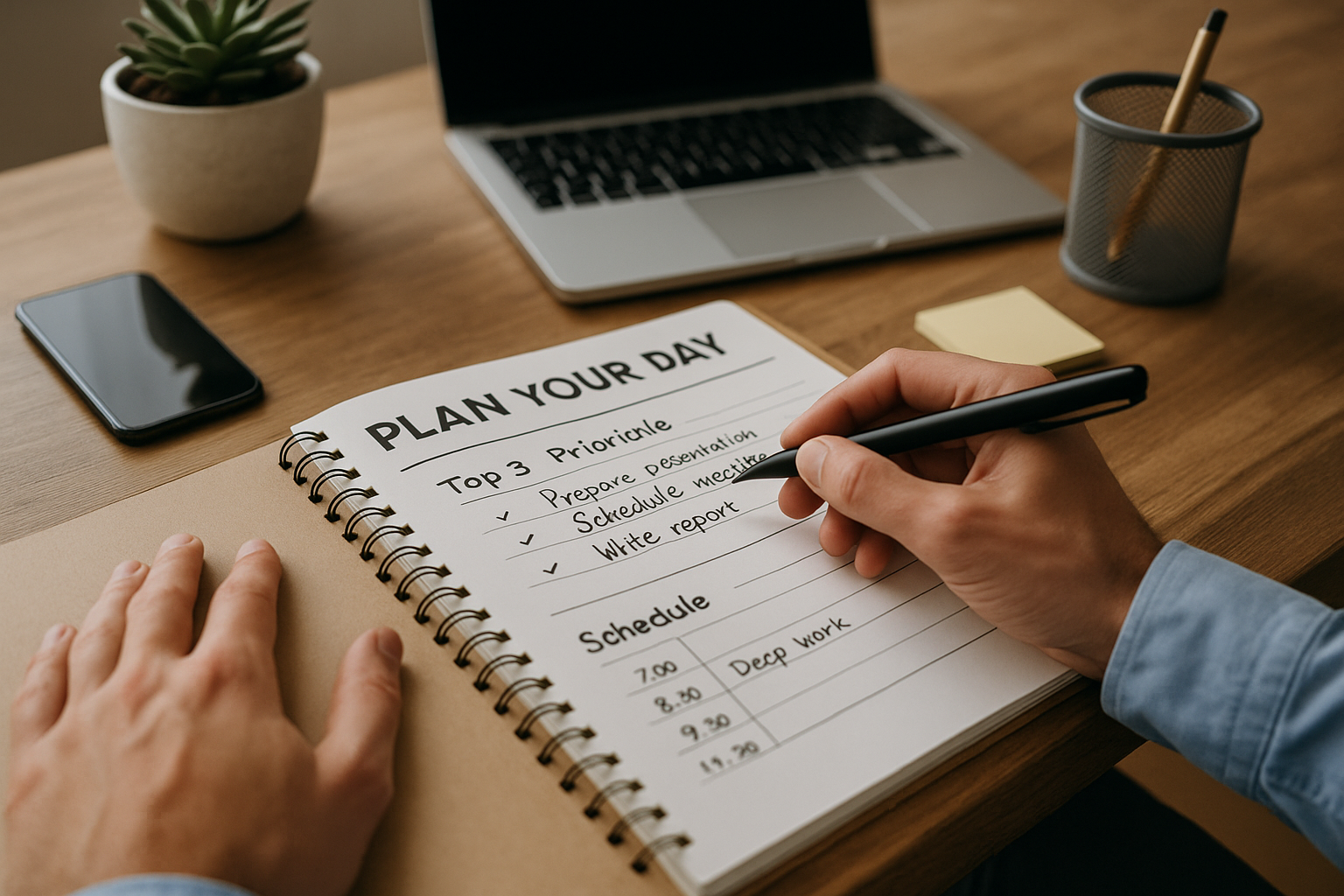Planning your day with intention is one of the most powerful habits you can build. When you know what to focus on—and when—you work smarter, reduce stress, and accomplish more with less effort.
In this article, you’ll learn how to plan your day step by step so you can stay productive, focused, and in control of your time.
Why Daily Planning Works
A daily plan gives your mind structure. It turns vague intentions like “get things done” into actionable steps. This clarity helps you:
- Prioritize what matters
- Avoid decision fatigue
- Reduce distractions
- Create a rhythm of focus and recovery
- End the day with a sense of progress
Let’s break it down into an easy, repeatable process.
Step 1: Start With Your Top 3 Priorities
Ask yourself: If I could only accomplish 3 things today, what would make the biggest difference?
These are your non-negotiables—high-impact tasks that move your goals forward.
Examples:
- Finalize a client presentation
- Schedule a doctor appointment
- Write 1,000 words for a project
Don’t overwhelm your list. Focus on what truly matters.
Step 2: Time Block Your Calendar
Time blocking means assigning specific blocks of time to your tasks, instead of leaving your day open-ended.
Here’s how:
- Use a digital or paper calendar
- Block time for deep work, meetings, breaks, and even lunch
- Include buffer time between tasks to avoid spillover
- Reserve time for admin tasks or emails (don’t let them dominate your day)
This structure creates flow—and reduces last-minute chaos.
Step 3: Batch Similar Tasks
Your brain takes time to switch between different types of work. Batching similar tasks improves efficiency.
Try batching:
- Emails and messages
- Creative work (writing, designing, planning)
- Calls or meetings
- Admin tasks
When you group similar activities together, you stay in the same mental mode longer—reducing fatigue and boosting focus.
Step 4: Use a Planning Tool That Fits Your Style
Your system should make planning feel easy—not overwhelming.
Options:
- Digital: Google Calendar, Notion, Trello, Todoist
- Paper: Daily planners, bullet journals, simple checklists
- Hybrid: Combine digital calendars with handwritten to-do lists
Choose what helps you stay consistent, not just what’s trendy.
Step 5: Include Breaks and Transitions
You are not a machine. Strategic pauses increase productivity and prevent burnout.
Include:
- A short break every 60–90 minutes
- A midday reset (walk, stretch, nap, lunch away from screens)
- A 10-minute wind-down at the end of your workday
Don’t skip these—they fuel your next burst of focus.
Step 6: Review and Adjust at the End of the Day
Take 5–10 minutes to reflect:
- What did I accomplish?
- What needs to be moved to tomorrow?
- What distracted me—and how can I reduce that tomorrow?
This review creates a feedback loop that improves your planning skills over time.
Bonus: Plan Tomorrow, Tonight
Spend a few minutes in the evening prepping for the next day. It clears mental clutter and helps you start your morning with intention, not stress.
You can:
- Set up your to-do list
- Review your calendar
- Prep your workspace or outfit
- Set your alarm with a purpose in mind
Tomorrow’s success starts the night before.
Final Thought: A Plan Is Power
You don’t need to micromanage every hour. But having a flexible, focused plan makes all the difference between reacting to your day—and leading it.
Start with just one new habit: maybe identifying your top 3 priorities or blocking 1 hour of deep work. Build from there.
Productivity isn’t about doing more—it’s about doing what matters most, with purpose and clarity.

